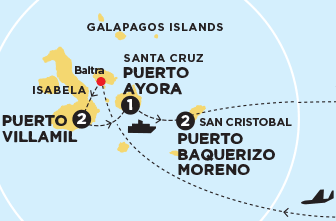httpvh://youtu.be/UerPibbclqU

Now I was lucky enough in April to be invited down to the Galapagos with Contiki.
Although I do travel quite a bit, the Galapagos has always seem like one of those destinations I would never quite get to. They are just so remote, preserved and protected, it truly is an honor to be allow to visit.
First off let’s get some facts in about the Galapagos:
The Galápagos Islands are an archipelago of volcanic islands distributed on either side of the Equator in the Pacific Ocean, 926 km west of continental Ecuador, of which they are a part. – Thanks Wikipedia 🙂
They are composed of 18 main islands, 3 smaller islands, and 107 rocks and islets. Only 4 of those islands contain accommodation that travellers are actually allowed to stay in: Isabela, Santa Cruz, San Cristobal and Floreana.

So as most people may know, the Galapagos are famous because of one man, Charles Darwin. He journeyed to this archipelago of volcanic islands upon the Beagle ship in 1835. His observations of the Galapagos’s unique species adaptations to such hostile environments, and their subtle variations between races of the same species on different neighboring islands, lead Darwin to the theory of natural selection. And thus, Darwin put forth the solution of how and why evolution occurred.
Having the opportunity to witness this first hand has all but confirmed that theory in my head. I mean seriously, how can you look at these creatures and not question how they can not only live but thrive here?
Isabela Island
To make things simpler I am going to break up my trip into the three islands we visited. Our first island we visited was Isabela, the largest and most volcanic of the three.

The first activity we took part in was actually not on Isabela Island at all but instead off on Tintorerias Island, a smaller, rockier island known for their iguana sanctuary.
Rules about walking along Tintorerias:
- You must stick to the path as the rocks are littered with iguana eggs.
- No touching anything. This is pretty much a standard golden rule in the Galapagos .
- You must keep 2 meters away from all wildlife. Even though most of the time the wildlife comes closer than that to you.
These are some of the hundreds of marine iguanas, they are black in color to camouflage to the rocks. There are also hundreds of lizards sharing the rocks with their fellow amphibians.
One of best ways to approach wildlife in the Galapagos and keep to the rules is to apply stealthy and non-abrasive travel transportation methods, such as kayaking to see the famous Blue Footed Boobies.
Now there are dozens of puns, jokes and cliche souvenirs you can buy about these birds. Personally I think a photo is worth much more than a souvenir.
Here is a little game for you, can you spot the penguin?
After docking our kayaks back on shore we ran into this fellow, chilling under the bench.
This happens quite a lot in the Galapagos, sea lions on abandoned ships or on the docks, stairs, everywhere just chilling. Honesty it’s like taking a step into another world. I know that “feeling” was mentioned before I came to visit, but the wildlife here are honestly not afraid of humans at all. My guess is due to the island’s isolation their ancestors never evolved to fear humans. And now with all the conservation efforts put in place by the Ecuadorian Government it seems as though it will most likely stay that way. This is a wonderful thing because I truly hope everyone who wants to can get the opportunity to experience the magical natural world of the Galapagos.
Giant Tortoises
The pride and joy of the Galapagos, just look at that face, what’s NOT to love.
Have you ever wanted to know what mating tortoise sound like? Well I found out and although I didn’t include it in my video it actually sounds exactly like you think it would: and old man’s hoarse groans and rawrs, slow, low and drawn out. Now that may or may not be more information than you ever wanted to know, but hey at least you learned something today? Oh and they will do that for hours, ramming their shells up against the females.
Oh Mother Nature, you are indeed a fascinating one.

















Did they explain why the bird’s feet are blue?
I’ve stated in my comments before this is one of my top destinations to see before I die. However I’d love to do it aboard one of the science vessels that do 7 to 10 day voyages around the islands. National Geographic and the Smithsonian do it. Do you think that would be a good way to see the islands? Thoughts?